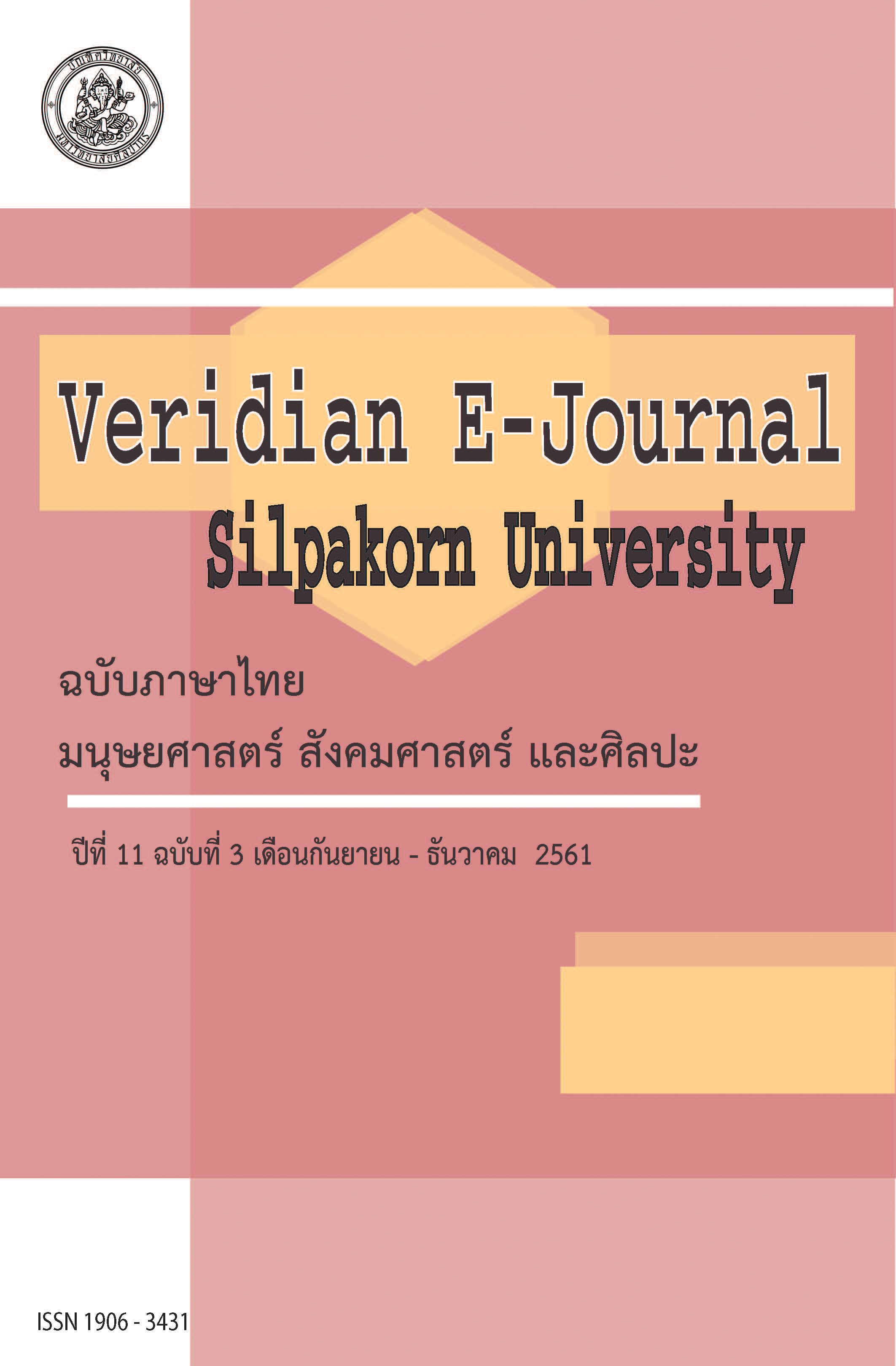การสร้างสรรค์และพัฒนากลุ่มสินค้าแฟชั่นสตรีมุสลิมสำเร็จรูป กลุ่มวิสาหกิจชุมชนมุสลิมบ้านรานอ อำเภอบันนังสตา จังหวัดยะลา (The Creation and Development of Muslim Women Ready-to-Wear for the Ban-Ra-No Muslim Community Enterprise, Ban-Nang-Sata District, Yala)
Main Article Content
Abstract
กลุ่มวิสาหกิจชุมชนมุสลิมบ้านรานอ อำเภอบันนังสตา จังหวัดยะลา ดำเนินธุรกิจการผลิตและจัดจำหน่ายสินค้าเครื่องแต่งกายแฟชั่นสตรีมุสลิม ทำการค้าในตลาดแถบภูมิภาคใต้ของประเทศไทยและตลาดเครื่องแต่งกายมุสลิมในประเทศมาเลเซีย ปัจจุบัน (2561) การประกอบธุรกิจดังกล่าวกำลังประสบปัญหาในผลประกอบการที่มียอดการจัดจำหน่ายในปริมาณน้อยเนื่องจาก กลุ่มผู้บริโภคไม่นิยมในรูปแบบของสินค้า การขาดเอกลักษณ์ของกลุ่มสินค้า ตลอดจนการขาดแคลนองค์ความรู้ของผู้ประกอบการในด้านการพัฒนาสินค้า งานวิจัยนี้จึงมีวัตถุประสงค์เพื่อสร้างสรรค์อัตลักษณ์และการจดจำใหม่ให้แก่กลุ่มสินค้าแฟชั่นมุสลิมของกลุ่มวิสาหกิจชุมชนบ้านรานอฯ เพื่อส่งเสริมการแข่งขันในตลาดการค้าสินค้าแฟชั่นมุสลิมสำเร็จรูป ด้วยการศึกษาขีดความสามารถของกลุ่มชุมชนทั้งในด้านการผลิตและการจัดการกลุ่มสินค้า ร่วมกับหลักการสร้างแบบตัดด้วยเทคนิคขั้นสูงเพื่อวิเคราะห์หาองค์ประกอบการออกแบบและการสร้างลักษณะจำเพาะพิเศษ รวมไปถึงปัจจัยด้านอื่น ๆ ที่เกี่ยวข้อง ได้แก่ ด้านเคมีภัณฑ์สิ่งทอสำหรับการเคลือบผิวใยผ้าประเภทนาโน (Encapsulation) ด้านการตลาดสินค้าแฟชั่นมุสลิม และ ด้านหลักการและแนวโน้มการออกแบบสินค้าแฟชั่นมุสลิม ผู้วิจัยใช้วิธีการวิจัยเชิงคุณภาพด้วยการสัมภาษณ์เชิงลึกกับกลุ่มวิสาหกิจชุมชนผู้ผลิตสินค้า ผู้เชี่ยวชาญในสาขาการตลาดสินค้าแฟชั่นมุสลิม และผู้เชี่ยวชาญด้านการออกแบบสินค้าแฟชั่นมุสลิม ร่วมกับการวิจัยเชิงปริมาณด้วยการสอบถามลักษณะความต้องการและความพึงพอใจในสินค้าจากกลุ่มผู้บริโภค จากผลการศึกษาพบว่าลักษณะของกลุ่มสินค้าที่มีความสอดคล้องกับความต้องการของกลุ่มเป้าหมายมากที่สุด คือกลุ่มสินค้าประเภทเครื่องแต่งกายยูเบาะห์ตามโอกาสการใช้งานชนิดชุดลำลองกึ่งทำงานและชุดลำลองกึ่งสังสรรค์ โดยกลุ่มเป้าหมายคือกลุ่มสตรีอายุตั้งแต่ 25-40 ปี มีรสนิยมที่ทันสมัยและให้ความสนใจกับสินค้าที่มีช่วงราคาอยู่ระหว่าง 600–3,000 บาท ด้านอัตลักษณ์ของระบบการจำหน่ายสินค้าพบว่ากลุ่มของสินค้ามีการแบ่งกลุ่มการจำหน่ายที่เหมาะสมออกเป็นสองกลุ่ม ได้แก่กลุ่มสินค้าระดับกลาง-ล่าง (Medium-Low) ที่มีรูปแบบการตัดเย็บที่เรียบง่าย ใช้แบบตัดที่เป็นมาตรฐานไม่ซับซ้อน ใช้ต้นทุนวัสดุในจำนวนน้อยและราคาไม่แพง ผลิตเป็นจำนวนมาก จัดจำหน่ายในราคา 600-900 บาท และกลุ่มสินค้าระดับกลาง (Medium-End) ที่มีรูปแบบหรูหรา ใช้แบบตัดที่มีความซับซ้อนและใช้วัสดุที่มีคุณภาพมากกว่ากลุ่มสินค้าในกลุ่มแรก จัดจำหน่ายในราคา 1,200- 3,000 บาท ด้านอัตลักษณ์ของการออกแบบกลุ่มสินค้าพบว่า การจดจำที่ดีระหว่างสินค้ากับผู้บริโภค เกิดขึ้นจากการนำเทคนิคการตัดเย็บและการสร้างแบบตัดขั้นสูงมาใช้ในองค์ประกอบที่สอดคล้องกันระหว่างโครงร่างเงาและรายละเอียดจำเพาะ ร่วมกับการใช้เทคโนโลยีการเคลือบผิวผ้าประเภทนาโน (Encapsulation) และเพื่อให้ได้ผลสรุปของรูปแบบกลุ่มสินค้าแฟชั่นสตรีมุสลิมประเภทยูเบาะห์ที่ตรงกับความต้องการของกลุ่มเป้าหมายมากที่สุด ผู้วิจัยอาศัยเทคนิคการวิจัยเชิงอนาคต EDFR (Ethnographic Delphi Futures Research) ด้วยการตัดสินด้านรูปแบบภาพลักษณ์ของกลุ่มสินค้าอีกครั้งจากคณะผู้เชี่ยวชาญก่อนนำไปพัฒนาเพื่อสร้างเป็นต้นแบบกลุ่มสินค้าแฟชั่นสตรีมุสลิม กลุ่มวิสาหกิจชุมชนบ้านรานอ-อำเภอบันนังสตา จังหวัดยะลา ที่เหมาะสมสำหรับการจัดจำหน่ายในตลาดสินค้าแฟชั่นสำเร็จรูปอันเป็นขั้นตอนสุดท้าย
The Ban Ra No Muslim Clothes Community Enterprise in Ban Nang Sata district, Yala produces and distributes Muslim women fashion products. The business is operated in the Muslim fashion market in the South and some products are exported to Malaysia. At present (2018), the business is experiencing low sales because the designs of the products are not popular among consumers and are still lacking in character. Another factor contributing to low sales is the lack of knowledge to develop products among business operators. This research aims to create an identity and raise awareness for the Ban Ra No Community Enterprise’s Muslim fashion products, in order to increase their competitiveness in the Muslim ready-to-wear market. The manufacturing capacity and management capability were studied as well as couture patternmaking technique, to identify and analyze elements of design and distinctive features. Other factors considered include textile chemicals for encapsulation, which are anti-bacterial, antifungal, and redolent; Muslim fashion marketing and Muslim fashion design trends. The researcher conducted qualitative research via in-depth interviews with the production community enterprise, Muslim fashion marketing experts, and Muslim fashion design experts. Quantitative research was also conducted via surveys to identify consumer needs and preference. Study shows that the type of product that is most preferred by the target market is Jubah, which are casual business and casual party. The target market for Jubah is females aged between 25-40, who are modern in style. The affordable price range is 600-3,000 baht. The products can be distributed in two groups, medium-Low products with simple pattern cutting, made of inexpensive materials, produced in bulks, and sold at 600-900 Thai baht, and medium-end products with luxurious designs with intricate pattern cutting, made of higher quality materials and sold at 1,200-3,000 Thai baht. Design-wise, consumers would recognize the products made with couture cutting techniques in concordance with silhouette, details, and encapsulation technology. In order to achieve Muslim women fashion products that are most suitable for the target group, the researcher conducted EDFR or Ethnographic Delphi Futures research by obtaining judgement from a committee of experts. Lastly, the researcher developed prototypes of Muslim women fashion products to be sold and distributed in the ready-to-wear market.
